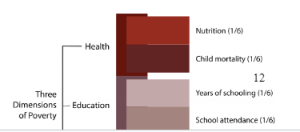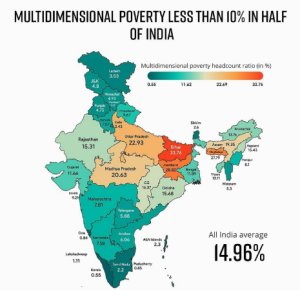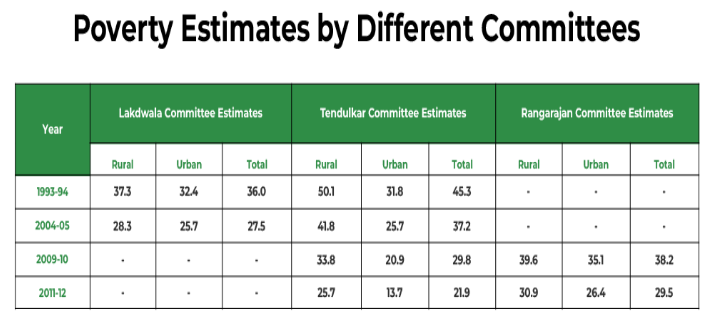Context:
- Niti Aayog has recently released the report ‘National Multidimensional Poverty Index: A Progress Review 2023’.
What is multidimensional poverty?
- Multidimensional poverty encompasses the various deprivations experienced by poor people in their daily lives – such as poor health, lack of education, inadequate living standards, disempowerment, poor quality of work, the threat of violence, and living in areas that are environmentally hazardous, among others.
Need of Multidimensional Approach:
- Consideration of non monetary poverty: Monetary and non-monetary measures of poverty are needed to better inform the policies intended to address the needs and deprivations faced by poor populations.
- Delinking economic growth and poverty: Economic growth does not always reduce poverty or deprivation and is not strongly associated with a reduction in other deprivations, such as child malnutrition or child mortality.
- Multidimensional aspect of poverty: Poverty is attributed to other factors like poor health, nutrition, lack of adequate sanitation and clean water, social exclusion, low education, bad housing conditions, violence, shame, disempowerment and much more.
- Targeted Poverty reduction strategy: The greater the availability of policy-relevant information on poverty, the better equipped policymakers will be to reduce it. For example, an area in which most people are deprived of education requires a different poverty reduction strategy from an area in which most people are deprived of housing conditions.
Global Multidimensional Poverty Index (MPI):

- Definition: The global MPI is an international measure of acute multidimensional poverty covering over 100 developing countries. It complements traditional monetary poverty measures by capturing the acute deprivations in health, education, and living standards that a person faces simultaneously.
- Released by: The global MPI was developed by the United Nations Development Programme (UNDP) and the Oxford Poverty and Human Development Initiative (OPHI).
- Indicators– Three broad indicators are measured which are health, education and standard of living, which are further subdivided into 10 sub-indicators, (kindly refer the schematic for more information.)
Global MPI Highlights with respect to India:
- Absolute poverty reduction: Deprivation in all indicators declined in India and the poorest States and groups, including children and people in disadvantaged caste groups, had the fastest absolute progress. India saw a remarkable reduction in poverty, with 415 million people exiting poverty within a span of just 15 years (2005/6–19/21).
- Nutrition deprivation: People who are multidimensionally poor and deprived under the nutrition indicator in India declined from 44.3% in 2005/2006 to 11.8% in 2019/2021, and child mortality fell from 4.5% to 1.5% in the same time period.
- MPI value: India was among the 19 countries that halved their global Multidimensional Poverty Index (MPI) value during one period – for India it was 2005/2006–2015/2016.
National Multidimensional Poverty Index by Niti Ayog:
- Based on the latest National Family Health Survey [NFHS-5 (2019-21)], this second edition of the National MPI represents India’s progress in reducing multidimensional poverty between the two surveys, NFHS-4 (2015-16) and NFHS-5 (2019-21).
- Indicators under NITI aayog MPI: Under the three broad indicators of health, education and living standards ,three dimensions are represented by 12 indicators such as nutrition, school attendance, years of schooling, drinking water, sanitation, housing, bank accounts among others.
Key highlights about the report:
- Decline in Multidimensional poor: India has registered a significant decline of 9.89 percentage points in the number of multidimensionally poor, from 24.85% in 2015-16 to 14.96% in 2019-2021.
- About 13.5 crore people came out of multidimensional poverty during the period, assessed by identifying “acute deprivations in health, education and standard of living” using United Nations-approved parameters.
 Fastest decline in Rural areas: rural areas witnessed the fastest decline in poverty from 32.59% to 19.28%, primarily due to decrease in the number of multidimensionally poor in States such as Bihar, Uttar Pradesh, Madhya Pradesh, Odisha, and Rajasthan.
Fastest decline in Rural areas: rural areas witnessed the fastest decline in poverty from 32.59% to 19.28%, primarily due to decrease in the number of multidimensionally poor in States such as Bihar, Uttar Pradesh, Madhya Pradesh, Odisha, and Rajasthan. - States with Least multidimensional poor: Delhi, Kerala, Goa and Tamil Nadu have the least number of people facing multidimensional poverty along with the Union Territories.
- States with highest multidimensional poor: Bihar, Jharkhand, Meghalaya, Uttar Pradesh and Madhya Pradesh top the chart where the percentage of total population who are multidimensionally poor is high.
- Poverty in urban areas: Multidimensional poverty in urban areas during the same period saw a decrease from 8.65% to 5.27%.
- State with largest decline: Uttar Pradesh registered the largest decline in the number of poor with 3.43 crore people escaping multidimensional poverty.
- MPI Value: Between 2015-16 and 2019-21, the MPI value has nearly halved from 0.117 to 0.066 and the intensity of poverty has reduced from 47% to 44%.
- SDG Target: India is on the path of achieving the SDG Target 1.2 (of reducing multidimensional poverty by at least half) much ahead of the stipulated timeline of 2030.
Significant achievements:
- Health: Schemes like Poshan Abhiyan and Anaemia Mukt Bharat have contributed to reduced deprivations in health.
- Sanitation: Initiatives such as Swachh Bharat Mission and Jal Jeevan Mission have improved sanitation across the country.
- Clean cooking fuel: The provision of subsidised cooking fuel through Pradhan Mantri Ujjwala Yojana (PMUY) has positively transformed lives, with a 14.6 percentage points improvement in cooking fuel deprivations.
- Banking: The percentage of people lacking access to banking reduced from 9.66 per cent to 3.69 per cent.
- Power supply: Deprivation went from 12 per cent to 3.27 per cent
- Other welfare measures: Initiatives like Saubhagya, Pradhan Mantri Awas Yojana (PMAY), Pradhan Mantri Jan Dhan Yojana (PMJDY), and Samagra Shiksha have also played a major role in significantly reducing multidimensional poverty in the country.
Significance of national Multidimensional Poverty Index:
- Understanding poverty intricacies: India’s adoption of the national MPI marks a significant milestone in understanding the complexities of poverty and creating inclusive solutions.
- Targeted intervention: By estimating the MPI at the district level, the country aims to prioritize reaching out to the most vulnerable communities through targeted efforts on specific indicators and dimensions.
- Policy formulation: The results and findings of the index provide valuable insights for policymakers and the wider community, facilitating progress towards achieving the UN’s Sustainable Development Goals (Agenda 2030) and reducing multidimensional poverty.
Way Forward:
- Equality of opportunity: The equality of opportunity needs to be increased through good quality and universal public provision of essential amenities and social services.
- Focusing on women and Scheduled Tribes: The low participation of women in the labour market and the slow progress among Scheduled Tribes is a major concern.
- Speedy Development of Infrastructure: Since the private sector is not attracted to make adequate investment in infrastructure, public investment needs to be stepped up for its development.
- Accelerating Human Resource Development:. Human resource development requires greater investment in educational facilities such as schools to promote literacy, technical training institutes and vocational colleges to import skills to the people.
- Give a voice to oppressed groups: Bias against caste and gender needs to be tackled first of all by providing a greater voice to traditionally oppressed and suppressed groups.
- Harnessing the power of technology: Technology has helped in reducing some of the access barriers in India, particularly in relation to access to information. Policymakers should focus on making technology cheaper and deepening its penetration.
- Widening access to quality basic services: A two-tier system has been created, with largely privatized quality education and health care for those who can pay, and a large population left to fend for themselves with very poor quality public services.
- Access to Credit: Availability of credit to the poor on easy terms can create the conditions for small farmers gaining access to productive resources.
Poverty Estimation in India:
- Several committees have been formed to study and propose methodologies for poverty line estimation based on either calorific consumption or per capita consumption expenditure.
- VN Dandekar and N Rath committee(1971):The committee recommended that the poverty line should be based on expenditure that would provide 2250 calories per day for both rural and urban areas, moving away from the previous emphasis on subsistence living.
- Alagh Committee(1979): The Committee constructed a poverty line for rural and urban areas by considering nutritional requirements and consumption expenditure.
- Lakdawala Committee(1993): The Committee proposed a poverty line based on the consumption pattern of the poor, as reflected in the Consumer Price Index for Industrial Workers (CPI-IW) and Consumer Price Index for Agricultural Labourers (CPI-AL).
- Tendulkar Committee(2009): The committee shifted away from calorie consumption-based poverty estimation, recommended a Uniform Poverty Line Basket (PLB) for both rural and urban areas and included private expenditure on health and education in poverty estimation.
- The current methodology for poverty estimation is based on the Tendulkar Committee.
- Rangarajan Committee(2012): The committee reviewed international poverty estimation methods and explored how they could be linked to eligibility for various poverty elimination schemes.

News Source: The Hindu
![]() 19 Jul 2023
19 Jul 2023

 Fastest decline in Rural areas: rural areas witnessed the fastest decline in poverty from 32.59% to 19.28%, primarily due to decrease in the number of multidimensionally poor in States such as Bihar, Uttar Pradesh, Madhya Pradesh, Odisha, and Rajasthan.
Fastest decline in Rural areas: rural areas witnessed the fastest decline in poverty from 32.59% to 19.28%, primarily due to decrease in the number of multidimensionally poor in States such as Bihar, Uttar Pradesh, Madhya Pradesh, Odisha, and Rajasthan. 
